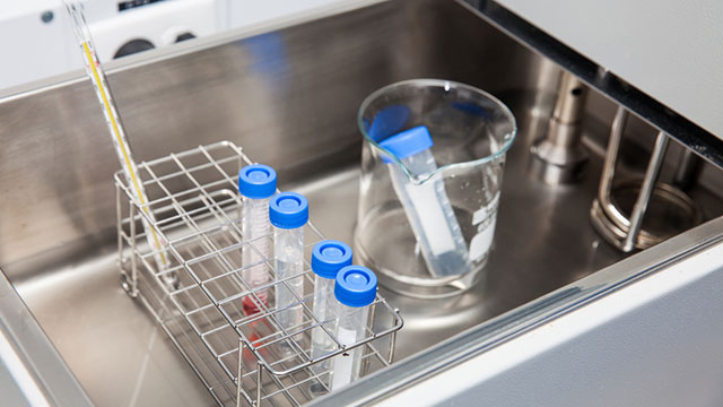Water baths are an importance piece of lab equipment in any laboratory. They have a wide range of uses and are a useful piece of equipment to have on hand.
Many labs use water baths to gently heat and maintain mixtures to a desired temperature, melt waxes or warm yeast and provide a safe way to heat flammable chemicals without an open flame.
Whether you have never used a water bath before or looking to purchase a new one, it is essential to understand what they are and how to use them.
In this guide, we share everything you need to know.
What Is A Water Bath?
A water bath is a piece of equipment that works as a heated water container. Scientists use them to incubate samples and keep them at a constant temperature. Almost all laboratories will have some kind of water bath, and they are a useful heat source for many different devices.
Water baths vary from a basic on-off type with no temperature control to more sophisticated baths with temperature control and thermal trip switches etc.
Constructed of a heating unit, a water chamber and a control interface, the heating element is usually housed inside at the base with a wire mesh or grille over the top. The bath is filled with water to the desired level (usually 5-10cm above the grille depending on what type of vessel is being heated) and then turned on. As the water circulates in the bath, the temperature is maintained and constant throughout use. Temperature regulation is usually controlled via a dial on the side of the unit. Thermal controls ensure that the water is heated to near enough that temperature and remains at that level. On newer units, an LED or LCD array may show you the desired temperature and another may show the actual temperature.
What Are Water Baths Used For?
Having many different uses, but primarily being used to heat up samples in a laboratory, they are commonly used to heat flammable chemicals, which are at risk of combusting if exposed to an open flame, as well as for maintaining cell lines. There are different types of water baths that are suited to different applications; for example, a circulating water bath keeps the temperature constant, while a shaking water bath can keep samples in consistent motion during heating. Most water baths can heat samples to between 5°C and 99°C; anything that needs heating higher than 100°C will need to use an alternative such as an oil, sand or silicone bath.
What is the Working Principle of a Water Bath?
In a laboratory the unit is fitted with a temperature sensor, which transfers the water temperature to the resistance value and amplifying and comparing with an integrated amplifier. The output is the control signal which efficiently controls the average heat power for the heating tube. This works to maintain the constant temperature within the water bath.
How Do You Prepare A Water Bath?
To prepare a water bath, fill the container to the desired level with distilled water. Once filled to the desired level, you can switch the water bath on and set your required temperature on the temperature controller. Wait until the water has reached the set temperature; the length of time this takes will depend on the temperature you need the water to be. You can use the thermometer to monitor the water temperature. Once it has reached the temperature, you can start using the water bath.
How Do You Use A Water Bath?
Using a water bath is straightforward, but it is crucial you get it right to avoid damaging or compromising your samples. The basic steps for a hot water bath are:
- Ensure the surrounding area is dry and clean.
- Connect the power supply.
- Ensure the water is at the desired level and high enough to cover the heating element.
- Switch the water bath on.
- Set the temperature controls to the desired temperature and wait until the thermostat shows it has heated enough.
- When heating, insert your sample(s) carefully. The temperature sensor will maintain the temperature during use.
- After use, remove the sample(s) and switch off the water bath.
How to Maintain A Water Bath?
No matter what type of water bath you use, proper maintenance is essential for a prolonged life.
Firstly, you must consider the type of water you are using. As mentioned above, distilled water works best because tap water can contain minerals that build up over time.
Secondly, drain the water bath each time to keep it in good condition and take the time to clean this equipment regularly.
To clean a water bath, make sure it is switched off and remove the container. Wipe down the seal to clear any debris and be very careful not to spill water into the unit, as it can damage electrical components.
Never use corrosive cleaning agents on a water bath, and only clean with a damp cloth and mild detergent.
For more information, feel free to get in touch with the helpful and friendly Evolve team today.
You might also be interested in
All the latest news from Evolve, all in one place
Scientific supplies for labs, utilities and more
Evolve is Malta’s fastest-growing science company for laboratory design services, high quality lab supplies and chemicals, as well as specialist scientific and medical equipment.
Our international customers include major pharmaceutical companies, medical cannabis firms, hospitals, schools, universities, public laboratories and the oil and gas sectors.
We take great pride in serving life critical industries such as pharmaceuticals, public utilities and testing laboratories.
If you’d like to speak to one of our experts on how Evolve can help your next science-led project, please get in touch with us today.


